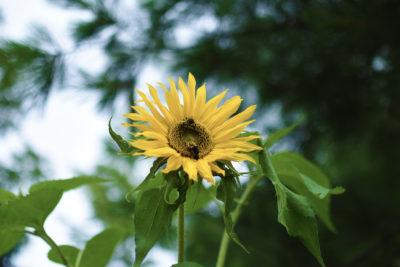
Although the “Bees!” exhibit at Harvard Museum of Natural History naturally creates a swarm of excited patrons, the new active hive is sure to be all the buzz.
The exhibit is part of the larger “Anthropods: Creatures that Rule” exhibition in the Cambridge museum. The bee portion, however, is a crowd favorite and draws a lot of interest from all ages, said Janis Sacco, director of exhibitions at the Harvard Museums of Science and Culture.
With interactive portions, including a live display on how to find the queen, the exhibit showcases the importance of honeybees and how they are part of an integral part of pollinators, both native and non-native to the Americas.
“There’s tremendous interest in bees, especially across the country there is growing interest in the honeybee,” Sacco said. “More broadly, we want to educate the public about animal behavior, natural history and evolution so we try to capitalize on what people are interested in and use that with our scientific knowledge as an opportunity to expand people’s knowledge about bees.”
Sacco emphasized the importance of not only educating the public about honeybees, but how they fit into the grand scheme of pollinators that we all depend on as humans.
One of the features that the exhibit educates visitors on is how bees swarm, meaning they follow the queen to try to find a new nest while other queens are installed. Just recently, the hive at the museum swarmed, leaving the museum to acquire a whole new hive. The new hive is lead by a new queen, and the live honeybees work tirelessly to rebuild their near empty hive in the museum.
“Now we have a younger hive there are empty cells and they are very actively building cells, so it is a super busy hive with a new queen,” Sacco said.
If a patron had visited the exhibit even a few weeks ago, it would be a completely different scene.
The museum is not alone in losing a hive. BU Beekeeping has recently lost all three of their hives through the winter, according to Ravi Patel, president of the BU Beekeeping club.
Patel, a junior in the College of Arts and Sciences, described the importance of museums educating the next generation about the vital pollinators, especially after the loss of hives.
“People don’t look at the pros that bees have to offer and the large role they play,” Patel said. “It’s great that they have these exhibits to raise awareness and teach the younger generation about bees and the prominent role that bees play in our lives and the ecosystem around us.”
Not only that, but Patel stressed the vital need for awareness of “the use of pesticides and climate change.”
“It’s important for our youth to understand this so they can look after the bees, and make sure our ecosystem is preserved and the best it can be,” Patel said.
Patel described that beekeeping is a “selective hobby” and a “dying art form.” The primary goal is to raise awareness about sustainability and educate the public on the pros of honeybees, rather than allow individuals to get caught up in their fears of being stung.
Michael Dietze, a professor in BU’s Earth and Environment Department specializing in ecology, commented on the intriguing ways that bees are “eusocial” animals, which the Harvard exhibit highlights.
The exhibit showcases these castes as well, showing how the all-female hive operates with a queen and worker bees, while sometimes producing males that find other hives to migrate to.
“They are fascinating group of organisms that are truly eusocial, which is interesting because we are social animals ourselves,” Dietze said. “They have evolved the level of social interaction that has extended to the point of morphologically distinct classes.”


























































































































